Abstract
The composition of the land snail fauna of central Europe is responsive to environmental conditions and undergoes changes throughout the Holocene. That holds also for the fauna of central-European Helicellinae, a group of dry-adapted western Palearctic snails with five species living in the Czech Republic. While one of them is currently spreading in the country, two, Candidula unifasciata and Helicopsis striata, are critically endangered, both with only a single surviving population. Although sharing a similar fate lately, these two species represent completely different histories. While C unifasciata is a rather recent immigrant in the area, H. striata is a relict species of the Pleistocene loess steppe, which is declining during the Holocene. However, the origin of the only known extant Czech population of H. striata is deemed to be dubious due to the untypical habitat inhabited, and within C. unifasciata two species or subspecies used to be distinguished, suggesting a dual origin of its populations. We present here sequences of a fragment of the 16S rRNA gene from two extinct and the last surviving populations of H. striata, and from two extinct populations of C. unifasciata from Bohemia, supplemented by Slovak samples of both. The obtained haplotypes of Bohemian C. unifasciata are different from the one found in western Slovakia, suggesting a different origin of the Western Carpathian populations. The sampled extinct Bohemian populations of H. striata shared an identical haplotype with the last living population, supporting native origin and conservation value of the latter. The causes of the disappearance of the two species are discussed.
Similar content being viewed by others
References
Anděra A. & Červený J. 2008. Změny v rozšíření králíka divokého (Oryctolagus cuniculus) na území České republiky (Lagomorpha: Leporidae). Lynx (Praha), n.s. 39 (1): 5–23.
Bieringer G. 2001. Verbreitung, Lebensraumanspriiche und Gefährdung der Osterreichischen Heideschnecke (Helicopsis striata austriaca Gittenberger 1969). Stap fia 77: 205–210.
Chiba S. 1999. Accelerated evolution of land snails Mandarinci in the oceanic Bonin Islands: evidence from mitochondrial DNA sequences. Evolution 53 (2): 460–471. DOI: 10.2307/2640782
Groeneberg D.S.J., Neubert E. & Gittenberger E. 2011. Reappraisal of the “Molecular phylogeny of Western Palaearctic Helicidae s.l. (Gastropoda: Stylommatophora)”: When poor science meets GenBank. Mol. Phylogen. Evol. 61 (3): 914–923. DOI: 10.1016/j.ympev.2011.08.024
Hlaváč V.F. 1949. Helicella candidula (Studer). Příroda (Brno) 42 (3-4): 52.
Hudec V. & Brabenec J. 1964. Zum Vorkommen der Schnecke Candidula soosiana (J. Wagner) in der ČSSR. Biológia (Bratislava) 19 (7): 522–540.
Juřičková L. 1995. Měkkýší fauna Velké Prahy a její vývoj pod vlivem urbanizace. Natura Pragensis 12: 1–212.
Korábek O., Petrusek A., Neubert E. & Juřičková L. 2015. Molecular phylogeny of the genus Helix (Pulmonata: Helicidae). Zool. Ser. 44 (3): 263–280. DOI: 10.1111/zsc.12101
Körnig G., Hartenauer K., Unruh M., Schnitter P. & Stark A. (eds). 2013. Die Weichtiere (Mollusca) des Lands SachsenAnhalt unter besonderer Berücksichtigung der Arten der Anhänge zur Fauna- fioraHabitatRichtlinie sowie der kennenzeichnenden Arten der Fauna- fioraHabitatLebensraumtypen. Der Reihe Berichte des Landesamtes fur Umweltschutz SachsenAnhalt 12/2013: 1–336.
Lees A.C. & Bell D.J. 2008. A conservation paradox for the 21st century: the European wild rabbit Oryctolagus cuniculus, an invasive alien and an endangered native species. Mammal Rev. 38 (4): 304–320. DOI: 10.1111/j.1365-2907.2008.00116.x
Ložek V. 1949. Studie českých stepí na základě recentních i fosilních měkkýšů. Rozpravy České akademie věd a umění, Třída II, Mathematickopřírodnická, Sv. 18, Roč. 58, Česká akademie věd a umění, Praha, 92 pp, 3 pls.
Ložek V. 1987. Otazník nad lačníkem. Z červené knihy našich měkkýšů. Živa 2: 67.
Ložek V. 1988. Stane se suchomilka Candidula soosiana dobrým druhem? Z červené knihy našich měkkýšu. Živa 4: 145–146.
Ložek V. 1990. Molluscs in loess, their paleoecological signi ficance and role in geochronology - Principles and methods. Quaternary International 7/8: 71–79. DOI: 10.1016/1040-6182(90)90040-B
Ložek V. 2009. Malakostratigra fie holocenního pěnovce u Stankovan na severním Slovensku [Malakostratigraphy of the Holocene tufa deposit at Stankovany (North Slovakia)], pp. 229-232. In: Zprávy o geologických výzkumech v roce 2008, Česká geologická služba, Praha [Geoscience Research Reports for 2008, Czech Geological Survey, Prague].
Matějů J., Nová P., Uhlíková J., Hulová Š. & Cepáková E. 2008. Distribution of the European Ground Squirrel (Sperm,ophilus citellus) in the Czech Republic in 2002-2008. Rozšíření sysla obecného (Sperm,ophilus citellus) v České republice v letech 2002 až 2008. Lynx (Praha), n.s. 39 (2): 277–294.
Petrbok J. 1936. Dva noví měkkýši pro Cechy. Cas. Nár. Muz. 110 (2): 13–16.
Pfenninger M. & Magnin F. 2001. Phenotypic evolution and hidden speciation in Candidula unifasciata ssp. (Helicellinae, Gastropoda) inferred by 16S variation and quantitative shell traits. Mol. Ecol. 10 (10): 2541–2554. DOI: 10.1046/J.0962-1083.2001.01389.x
Pfenninger M., Nowak C. & Magnin F. 2007. Intraspeci fic range dynamic and niche evolution in Candidula land snail species. Biol. J. Linn. Soc. 90 (2): 303–317. DOI: 10.1111/j.1095-8312.2007.00724.x
Pfenninger M. & Posada D. 2002. Phylogeographic history of the land snail Candidula unifasciata (Helicellinae, Stylommatophora): fragmentation, corridor migration, and secondary contact. Evolution 56 (9): 1776–1788. DOI: http://dx.doi.org/10.1554/0014-3820(2002)056[1776:PHOTLS]2.0. CO;2
P fieger V. 1980. Snails of the Helicellinae (Gastropoda) subfamily in CSSR. Sborník Národního Muzea v Praze, Řada B 36: 53–171.
Pokorný P., Chytrý P., Juřičková L., Sádlo J., Novák J. & Ložek V. 2015. MidHolocene bottleneck for central European dry grasslands: Did steppe survive the forest optimum in northern Bohemia, Czech Republic? Holocene 25 (4): 716–726. DOI: 10.1177/0959683614566218
Razkin O., GómezMoliner B.J., Prieto C.E., MartínezOrtí A., Arrébola J.R., Muńoz B., Chueca L.J. & Madeira M.J. 2015. Molecular phylogeny of the western Palaearctic Helicoidea (Gastropoda, Stylommatophora). Mol. Phylogen. Evol. 83: 99–117. DOI: 10.1016/j.ympev.2014.11.014
Rohlena J. 1920. Helix candidula Stud. a Sideritis montana L. Věda přírodní 1: 146.
Řezáč M. & Strnadova V. 2001. Faunistické údaje ze středních Čech. Muzeum a současnost, Roztoky u Prahy, Řada přírodovědná 15: 3–7.
Smolíková L. & Ložek V. 1964. The Holocene Soil Complex of Litoměřice. Sborník geologicých věd, Róada A, Antropozoikum 2 (1963): 41–56.
Steinke D., Albrecht C. & Pfenninger M. 2004. Molecular phylogeny and character evolution in the Western Palearctic Helicidae s.l. (Gastropoda: Stylommatophora). Mol. Phylogen. Evol. 32 (3): 724–734. DOI: 10.1016/j.ympev.2004.03.004
Šťastný K., Bejček V. & Hudec K. 2006. Atlas hnízdního rozšíření ptáků v České republice 2001-2003. Aventinum, Praha, 453 pp. ISBN: 80-86858-19-7.
Tamura K., Stecher G., Peterson D., Filipski A. & Kumar S. 2013. MEGA6: molecular evolutionary genetics analysis version 6.0. Mol. Biol. Evol. 30 (12): 2725–2729. DOI: 10.1093/molbev/mstl97
Uličný J. 1892-1895. Měkkýši čeští. Klub přírodovědecký, Praha, 208 pp.
Wagner J. 1933. Egy új Helicella-faj Magyarország faunájában. Állattani Közlemények 30 (3-4): 151–159.
Wiktor A. 2004. Ślimaki lądove Polski. Wydawnictvo Mantis, Olzsztyn, 302 pp. ISBN: 83-918125-1-0
Welter-Schultes F.W. 2012. European nonmarine molluscs, a guide for species identification. Bestimmungsbuch für europäische Land- und Süsswassermollusken. Planet Poster Editions, Göttingen, 679 pp. ISBN-10: 3-933922-75-5, ISBN-13: 978-3-933922-75-5
Acknowledgements
This study was supported by the Czech Science Foundation (GAČR), project no. 13-08169S and Czech-Norwegian Research Programme 7F14208. We thank Jiří Kovanda for material of Candidula unifasciata from Slovakia and Alena Peltanová and Jana Dvořáková for some unpublished faunistic data, and a rewiever for comments and improving the language.
Author information
Authors and Affiliations
Corresponding author
Rights and permissions
About this article
Cite this article
Korábek, O., Juřičková, L. & Ložek, V. History of two critically endangered grassland snails (Pulmonata: Helicellinae) in the Czech Republic with first molecular data on extinct populations. Biologia 70, 1102–1107 (2015). https://doi.org/10.1515/biolog-2015-0123
Received:
Accepted:
Published:
Issue Date:
DOI: https://doi.org/10.1515/biolog-2015-0123




